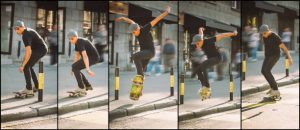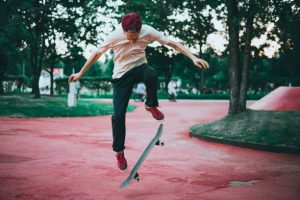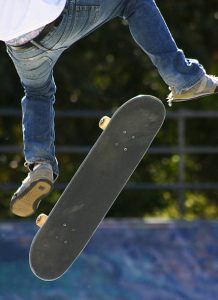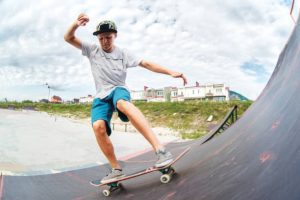Introducing skateboarding tricks and maneuvers to youngsters opens up a world of excitement and skill-building. Starting with basic skateboarding techniques and gradually progressing to more advanced maneuvers, young or new skaters can embark on a journey of growth and self-discovery. From mastering the art of easy skateboard tricks for beginners and skateboarding techniques for kids to attempting more challenging feats and advanced tricks, each skateboard trick offers children a chance to test their skate limits and enjoy the thrill of accomplishment.
As they learn to balance and coordinate their movements on a skateboard, executing moves like the nose manual or experimenting with different front foot placements becomes a source of fun and accomplishment. So, whether they’re venturing into the world of beginner skateboard riding techniques or exploring the intricacies of other moves, like doing a tic tac or a kick turn or jumping off of flat ground, this sport offers an engaging avenue to give youngsters an avenue to express themselves, including the ability to do riding switch and be part of the vibrant skateboarding community.
We understand how exciting it can be when your child shows an interest in this exhilarating sport. As parents or guardians, we often worry about their safety and whether they’re ready to perform certain maneuvers. Here at FamilyHype, we value the family unit and want to ensure that your child remains safe while developing their skills.
We’ve compiled a list of the best techniques that children and youngsters can learn which are safe yet challenging enough to keep them motivated. These techniques start from foundational skills like the Ollie and Manual before moving on to more advanced ones like Pop Shove-It and Kickflip. We’ll also provide tips on how to maintain motivation while progressing their skills safely.

So, let’s dive into the exhilarating world of skateboarding for kids – nurturing your kid’s passion while ensuring safety first! We invite you to share your feedback with us about your experience, opinions, and any trick you may have to share with other parents.
Cool and easy skateboard tricks for kids, such as the Ollie, Manual, Pop Shove-It, and Skateboard Kickflip, provide youngsters with the opportunity to develop balance, coordination, and perseverance while having fun and staying safe. We hope that by introducing these stunts to your children, they will be able to aim high and start young in this challenging yet rewarding sport. Start with a step guide to master the front trucks and progress to more advanced tricks like rock to fakie. Watching Red Bull skate videos can also be a great way to know what tricks to learn and easy skateboard techniques. Practicing kick turns, a tic tac, and other basics will pave the way for mastering more complex moves and advanced tricks.
Skateboarding Safety For Kids
Let’s discuss techniques, but first, let’s remember the important safety basics and precautions—they’re essential to having fun when riding boards without injuries!
- Make sure to invest in a high-quality skateboard and safety gear to prevent any potential accidents. Wearing a helmet when skateboarding is a must to protect your head. Don’t forget to invest in protective skateboarding gear such as knee and elbow skate pads.
- Opt for smooth, flat surfaces or designated skate parks with ramps and obstacles suitable for your skill level. Avoid high-traffic areas or places with potential hazards when performing easy skateboarding tricks.
- Practice falling safely by tucking in your arms and rolling with the fall rather than trying to break the impact with your hands or wrists. Learning proper falling tricks when riding boards can prevent serious injuries.
- Communicate with others about your skill level and intentions, especially when sharing skate ramps or skate obstacles. Being aware of each other’s tricks enhances everyone’s skate safety. For beginners, starting with a tic tac or a kick turn can be beneficial. As you progress, you can try more advanced tricks like rock to fakie. Watching Red Bull skate videos can provide inspiration and tricks to learn. Don’t forget to try riding switch and use a step guide to master kick turns and front trucks.

Skateboarding Trick: The Ollie
Mastering the Ollie, you’ll feel as if you’ve unlocked a superpower, allowing your board to leap into the air with a swift flick of your one foot, paving the way for a more advanced stunt. This is a fun and creative activity that’s popular among people of all ages. By mastering the Ollie, you can impress your friends and family as you show off your skills. The key to success with Ollie is practice and perseverance for your children. Through diligent practice, you can master the Ollie and use it to perform amazing maneuvers on your child’s skateboard. It’s known as one of the easy skateboard tricks for beginners, so have at it!

Skateboarding Trick: The Manual
Let’s dive into the Manual, an important skateboarding stunt and a must-know for every budding skateboarder. We’ll guide you step by step on how to perform this stunt, with an emphasis on the importance of perfecting your balance and maintaining control of your upper body. Mastery of this skill not only enhances your technique repertoire but also significantly improves your overall control and stability on the board. Additionally, learning tricks like the tic tac can help you navigate better and practicing with Red Bull videos can provide great insights. Also, ensure your front trucks are well-adjusted for better performance.
How To Perform A Manual Skating Trick
Engaging in a manual skateboarding stunt, you’ll find your balance and finesse truly put to the test. It’s among the skate Manual challenges for kids that can be demanding but rewarding. It’s also counted as one of the easy skateboard tricks for beginners.
The skate manual is a fundamental stunt that involves riding on the two back wheels of the skateboard while keeping the front wheels elevated off the ground. To perform a manual, the rider shifts their weight towards the back of the board, maintaining a delicate balance to keep the front wheels off the surface.
Perfecting Skating Balance
Perfecting your balance isn’t just about nailing the trick, it’s also about maintaining control and stability on your kid’s skateboard. Understanding stance variations will help in mastering board control. Tricks to learn for beginners are not that easy to do, so be patient. You can practice many easy skateboard tricks, so before all that, enhance your balance first.

Skateboarding Trick: The Pop Shove-It
With a swift flick of the wrist and a cool spin under your feet, you’re pulling off the Pop Shove-It, a crowd-pleaser in any skate park, demonstrating your skills in executing flat-ground skateboarding stunts. This maneuver is a staple of street skating’s golden era and comes with variations, too. This is an incredibly versatile sport, and it’s easy to see why the Pop Shove-It has become one of its most popular maneuvers. It’s an impressive feat of balance, coordination, and agility that can be customized with minor variations to fit any rider’s style.
Whether you’re a beginner or a pro, there’s something special about mastering the Pop Shove-It. Mastering any tricks for beginners is fun!
Skateboard Trick: The Kickflip Trick
Next up on our journey, we’re diving into one of the most iconic moves: the Kickflip. Perfecting this move is a rite of passage for any young rider, and with practice and patience, we’ll help you get there, fostering a sense of belonging in the broader skateboarding for kids community.
The kickflip is a fundamental and iconic technique where the rider pops the tail of the board, executes a flick with the front foot, causing the board to flip in the air, and lands with the grip tape facing up. To perform a kickflip perfectly, ensure proper foot positioning, with the front foot forward and slightly diagonally toward the nose of the board and the back foot placed on the tail.
Pop the tail down with a forceful snap, slide the front foot’s toes off the edge to initiate the kickflip, and level out the board with the front foot to control the flip. Keep the shoulders square, maintain balance, and commit to the landing with both feet over the back bolts, especially when attempting one of the hardest skate tricks. Practice consistently, pay attention to timing, and remember to flick the board downward to get a clean rotation.
- Master the ollie before attempting the kickflip.
- Practice the flick motion without popping to get the motion down.
- Keep your body centered over the board during the trick.
- Start with small flicks and gradually increase your flick’s power.
- Land with both feet simultaneously to maintain stability.
- Keep your eyes focused on the board for better control.
Learning The Kickflip
Mastering the kickflip isn’t just cool, it’s a rite of passage in this world! We need to understand mechanics and establish solid board control, ensuring that the board stays under your feet the entire time during complex moves like the backside boardslide. In other words, learning the kickflip is a pivotal step in mastering flat-ground techniques and progressing toward more intermediate maneuvers. To execute this classic stunt, it’s crucial to gain speed before initiating the pop and flick motion.
Placing your left foot just right on the board, the kickflip involves a swift kick of the back foot to make the board flip beneath you. The kickflip, alongside other foundational moves like the nose stall and feeble grind, forms a bridge between basic flat-ground moves and more advanced skills. As you dedicate time to perfecting this technique, you’ll be on the path to confidently flipping the board for kids with precision, establishing a solid foothold in breathtaking techniques. Skateboard tricks are entertaining to do, and it will take time even to learn the easiest skateboard tricks, so be patient on your journey.
Improving The Kickflip
Mastering the kickflip is a triumph, but there’s always room to improve. Here at FamilyHype, we want to help you enhance your flip mechanics and explore kickflip variations, taking your skills to the next level with more advanced skate movements. We want you to enhance your skateboard tricks.
Let’s take a look at how you can refine your skills:
- Understanding Skateboarding Flip Mechanics: Pay attention to foot placement, practice flicking, and catching, and experiment with the angle of your kick.
- Trying Skateboarding Kickflip Variations: Take your maneuvers to the next level with double flips, varial flips, and other variations. Try different stances and advanced tricks for even more variety.
By continually refining these skills, you’ll stay motivated, grow your abilities, and be ready for our next discussion: maintaining enthusiasm while advancing in this sport.
Maintaining Motivation And Progressing Skills For Tricks
We understand that maintaining motivation and progressing skills in this sport can be quite a challenge, especially for youngsters. By breaking down complex skate maneuvers into smaller, manageable tasks and promoting regular training sessions, we can help keep that spark of enthusiasm alive while steadily improving their skills on the board. Watching Red Bull skate videos or practicing simple tricks like the tic tac can be a great start.
Setting Achievable Goals
Setting achievable goals, even starting with the absolute basics, can help make the journey more enjoyable, fulfilling, and rewarding. This process can breed confidence, motivation, and a sense of accomplishment in this exciting sport. It’s not about rushing, but rather growing steadily. When it comes to skating, it’s important to make sure that practice becomes a regular part of your routine.
Encouraging Consistent Practice
Consistent practice is your key to becoming a master of any technique. Like the repetitive rhythm of wheels hitting the pavement, it’s your secret weapon in elevating your skills. It may take some time and repetition, and we all fall on our way, but it’s worth it. Progress should be celebrated, no matter how small, as it’s a step closer to mastering those impressive skate stunts. Skateboarding for kids is a great way to stay active, have fun, and learn new skills. To become a successful young skateboarder, you must have the right equipment and master the basics.
Conclusion
It is safe to say that the art of skateboarding for children is a tapestry woven with intricate moves, where foot position and board control intertwine. From the pivotal importance of the kick turn and heel flip to executing skate stunts like the hippie jump and mastering the trick list for kids, the community thrives on creativity and camaraderie.
Whether you’re perfecting your right foot positioning by watching helpful YouTube videos or confidently exploring riding switch stance, each movement contributes to your growth. With the versatile fakie kick turn and the exhilarating board forward on a vert ramp, riding your board offers endless opportunities to push boundaries and express yourself.
Of course, this requires mastering stunts for beginners first – such as Ollies, Manuals, Pop Shove-Its, and Kickflips. As your youngsters progress, they can explore more complex skate moves and experiment with different styles, such as vert skating, street skating, slalom skating, and longboarding.
Frequently Asked Questions (FAQs)
What Is The Best Way To Practice Skateboarding?
Consistent practice, focusing on fundamentals, setting goals, and seeking guidance or lessons from experienced skaters are effective ways to improve your skills. Start from the basics before you move on to doing skateboard tricks. Learning stuff like the fakie or how to make the easiest pivot requires consistent effort from your end. Skateboarders can also learn by searching on Google or YouTube.
Can I Practice Riding My Board At Home?
You can practice riding at home by setting up a mini skate park, using balance boards, working on strength and conditioning exercises, and watching video tutorials on tricks to learn and new stunts.
How Do You Start Learning Techniques On Your Board?
Begin by mastering basic skills like ollies and manuals. Break down stunts into smaller components, practice each part separately, and gradually put them together. Start with smaller obstacles before progressing to more challenging stunts. Skateboard tricks to learn are not easy, but you can do it as long as you make time and effort to practice.
How Do I Get Comfortable Riding My Board?
Spend time on the board, work on balance exercises, practice basic movements, and gradually challenge yourself to build confidence and familiarity with it.
Why Is It So Hard To Learn How To Ride My Board?
This sport requires mastering balance, coordination, and precise timing, making it challenging for beginners. The learning curve is steep, but consistent practice, patience, and determination are key to improvement.
How Do I Stop Being Scared Of Falling?
Falling is a part of learning, and unfortunately, sometimes it may lead to broken bones. Learning proper falling techniques and wearing safety gear can help reduce fear. Start with smaller intermediate moves and build confidence gradually to overcome fear. Practice kick turn and tic tac to gain more control.
How To Skate Without Pain?
Properly fitted and cushioned skate shoes, wrist guards, and knee pads can help reduce discomfort. To prevent pain and injuries, focus on maintaining good posture and avoiding overexertion. Consider learning rock to fakie to distribute weight effectively.
How Can I Skate More Smoothly?
Work on your balance, weight distribution, and foot placement to improve your overall stability on the skateboard. Invest in good grip tape. Smoothly transition your weight during turns and landings to achieve a fluid riding style. Practice riding switch and kick turns for better maneuverability.
How Do You Stop While Skating?
To stop on a skateboard, gradually slow down by dragging your back foot on the ground, or use the foot brake technique (pushing your sole against the ground). Practice stopping techniques in a controlled environment before using them in more challenging situations. Watching Red Bull skate videos can help you learn new techniques.
How Can I Get Better At Skating Without Doing It?
While nothing replaces actual skateboarding practice, you can improve your skills indirectly by watching skate videos, visualizing skate tricks, cross-training for skate strength and balance, and doing skate-specific workouts. Study front trucks setup and techniques to enhance your understanding of the board.
Last Updated on July 4, 2024 by Bernadine Racoma
DISCLAIMER (IMPORTANT): This information (including all text, images, audio, or other formats on FamilyHype.com) is not intended to be a substitute for informed professional advice, diagnosis, endorsement or treatment. You should not take any action or avoid taking action without consulting a qualified professional. Always seek the advice of your physician or other qualified health provider with any questions about medical conditions. Do not disregard professional medical advice or delay seeking advice or treatment because of something you have read here a FamilyHype.com.